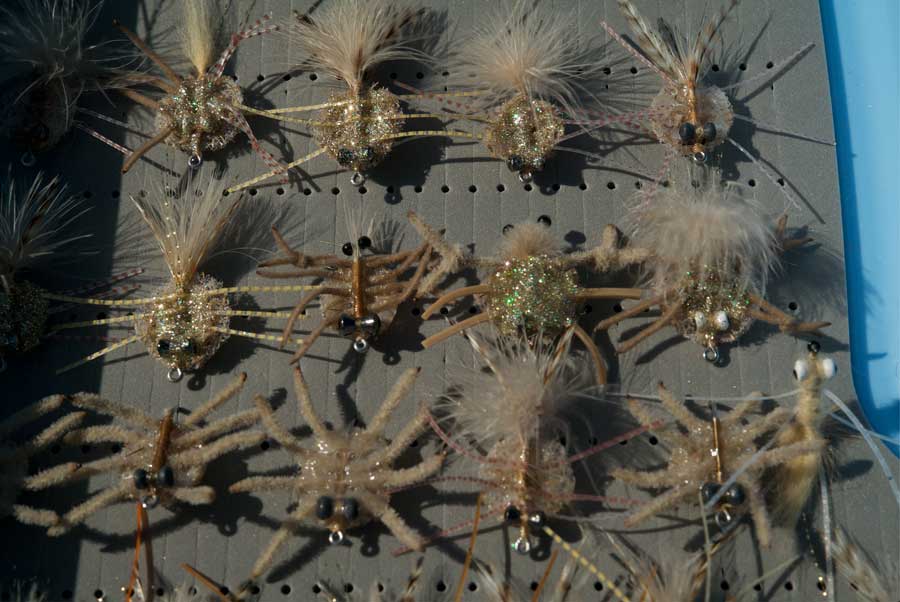“We hardly ever realize that we can cut anything out of our lives, anytime, in the blink of an eye.”
—Carlos Castaneda, Journey to Ixtlan
On numerous fly fishing trips to Mexico over the past 13 years, I’ve brought home all sorts of souvenirs. But until a trip in March, I had never brought back toilet paper.
It’s called papél sanitário in Spanish, and back home in the United States people were hoarding it in panic as COVID-19 and lockdowns spread across the country. I had been chasing permit, bonefish, and tarpon for several days in rural Mexico. During nine days of fly fishing and travel in the Yucatan Peninsula, the novel coronavirus went from being a faint American concern to a full-blown national emergency.
Harboring fewer than 400 souls at the far southern tip of Mexico’s Caribbean coast, the small fishing village of Xcalak was arguably one of the best places to ride out a pandemic. My friends and I, however, were headed away from elective recreational seclusion and toward the forced isolation of quarantines and social distancing.
The only sure thing was uncertainty. But we had TP.
Return on Investment
The journey to Xcalak requires more work than similar Caribbean destinations, but the effort yields abundant rewards. From the continental United States it takes a flight, a rental car, a five- to six-hour drive, and two extra travel days to break up the drive to and from Cancun. The payoff is reduced fishing pressure, an opportunity for cultural immersion, and one of the best travel fly fishing bargains you’ll find.
Xcalak isn’t for everybody. Outside of fishing, diving, and snorkeling, options are limited. There’s no nightlife or kitschy tourist attractions. It’s as far from the all-inclusive resorts of Cancun as you can get, a place with off-grid accommodations where you won’t find air conditioning.
But you’ll discover countless miles of Chetumal Bay’s sublime saltwater flats with lightly pressured bonefish and permit. There’s also easily accessible fishing along the Caribbean coast, where the planet’s second-longest barrier reef protects the beach from heavy surf. Brackish lagoons with tarpon and snook present additional opportunities. Independent guides run trips out of the village for a fraction of what you’ll pay in other popular destinations. Anglers interested in blazing their own trail will find some of the most accessible do-it-yourself saltwater fly fishing prospects on the Yucatan Peninsula.
I found Xcalak (pronounced ISH-kah-lahk) in 2007. I booked a half-day guided trip with Captain Victor Castro, who no doubt needed all of his skill and patience—as well as a measure of lucto lead a rank neophyte with a borrowed 8-weight to his first bonefish. It was the first evolutionary step toward a fixation with Trachinotus falcatus, commonly called “black-tailed devils,” or by their Spanish name, palometa, but sometimes known by more contemptuous monikers like “f****** permit.”
On the Road
Our crew flew into Cancun on a Friday afternoon. Lee Reddmann, an accountant with fly fishing obsessive disorder, and Casey Hughes, a trout fishing guide who represents several outdoor-industry companies, arrived with me from Little Rock. Michael DeJarnette, a friend since childhood, came in from Park City.
With the back of our rented Dodge Caravan looking like a mobile fly shop, we took off on the hour-and-a-half drive to Tulum. Unless flights arrive before noon, it’s best to break up the trip from Cancun to Xcalak. The route consists mostly of well-maintained federal highways, but animals, pedestrians, and long stretches of remote roadway can make nighttime driving sketchy.
The stop in Tulum leaves three-and-a-half hours of driving for the final leg to Xcalak. It also serves as a traveler’s decompression chamber, where the city’s bohemian ethos and tourism scene offer a transition zone between regular life and Xcalak’s extreme isolation.
We found food trucks and filled up on nachos, quesadillas, and empanadas, a solid base for multiple rounds of various social lubricants. Things got fuzzy after we drank the pox (pronounced poash)—a traditional distillation of corn, wheat, and sugar cane that’s like Maya moonshine. The shamans used it to connect with the spirit world; we used it to disconnect from the actual world.
Fortified by coffee the next morning, we headed to the Chedraui supermarket for food, beer, and booze. Xcalak only has a couple small stores and a grocery truck that delivers on a loose schedule, so it’s best to pick up provisions on the way down.
The road carried us through the heart of the Maya world. We passed the ruins at Muyil, a vestige of the Maya civilization’s bygone splendor and its remarkable achievements in astronomy, mathematics, art, and engineering. As we slowed down through small towns, their inhabitants were a reminder that the Maya still walk upon this big porous limestone slab.
About two hours after leaving Tulum, we stopped at the Pemex outside Majahual to top off the van’s gas tank, and another hour later we were looking at a big sign that read, “Bienvenido Xcalak,” where the Caravan’s tires rolled over the last patch of asphalt they’d touch for a week.
The Inside Scoop
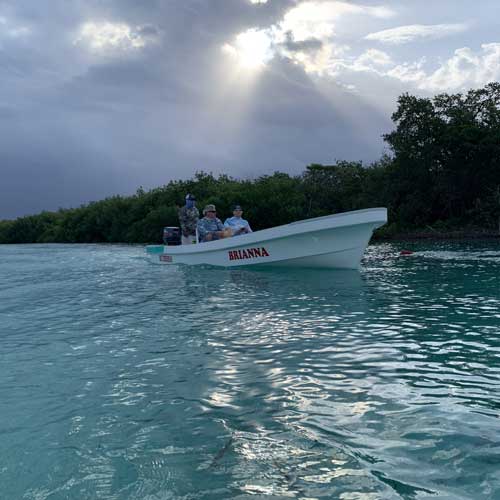 Using a guide dramatically increases the odds of success in Xcalak. Local knowledge and experience aside, another factor is the accessibility afforded by their boats. While the wading DIY angler finds abundant opportunity around Xcalak, the guided fly angler can cover more water and reach otherwise inaccessible spots. Boats also make it easier to spot fish.
Using a guide dramatically increases the odds of success in Xcalak. Local knowledge and experience aside, another factor is the accessibility afforded by their boats. While the wading DIY angler finds abundant opportunity around Xcalak, the guided fly angler can cover more water and reach otherwise inaccessible spots. Boats also make it easier to spot fish.
We arranged two boats for five days with Victor Castro and his crew at Osprey Tours (xcalak-flyfishing.com). More than a fishing guide, Castro has become a valued friend. We met him and his nephew Felipe Miravete at eight a.m. the first day. “Mucho viento” were Miravete’s first words, but the 15- to 20-mph wind wasn’t the only issue. Clouds obscured the sun and showed few signs of breaking up. The southern Yucatan was experiencing a norte, and while the cooler north wind and lower humidity made for great sleeping conditions, it would probably hurt the fishing.
Hughes and I climbed in Miravete’s panga and motored south, turning west into the Zaragoza Canal, a manmade cut connecting the Caribbean with Chetumal Bay about three miles north of Bacalar Chico, a narrow, serpentine waterway separating Mexico from Ambergris Caye, Belize. Miravete killed the Yamaha outboard on a massive flat within sight of the canal.
Although he stands barely 5 feet tall, Miravete’s eyes and intense determination make him a giant on the flats. He’s a jokester, usually smiling and laughing away from the water, but in the stern of a panga he takes on a resolute mien. With a light drizzle dimpling the shallow water, Hughes struck the trip’s first fish: a solid bonefish, macabí, that Miravete spotted in spite of the miserable conditions.
Sábalo Sorrow
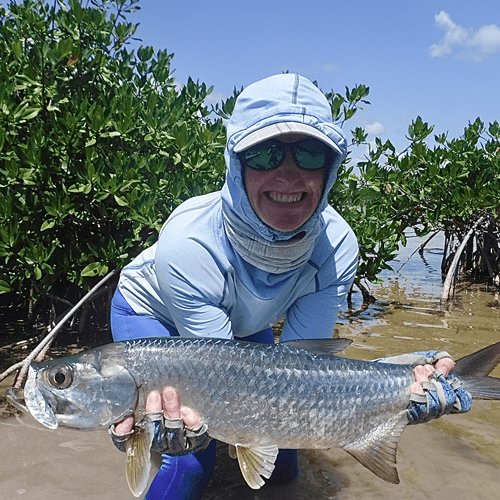 The wind was still strong out of the northeast the next day, but we had sunshine. Hughes and I hit the water with Miravete again, making a longer run north in the bay. About 45 minutes after shutting down the motor, Miravete spotted two big, murky shapes swimming parallel to the boat at 75 feet.
The wind was still strong out of the northeast the next day, but we had sunshine. Hughes and I hit the water with Miravete again, making a longer run north in the bay. About 45 minutes after shutting down the motor, Miravete spotted two big, murky shapes swimming parallel to the boat at 75 feet.
“Big tarpon,” he said.
With a 10-weight rigged for the smaller tarpon we anticipated, we needed to scale up quickly. Hughes used a heavy leader from Miravete’s tackle bag, chaotically re-rigging in the floor of the panga.
“It’s like tying a knot with Weed Eater line,” Hughes said.
Pushing the panga with a pole fashioned from a sapling, Miravete chased the fish across the flat. Hughes fastened a red streamer from Miravete’s box to the leader and stepped up to the casting deck. Ten minutes and 400 meters after initially spotting them, the two tarpon were again parallel to the boat.
“Nine o’clock,” Miravete said. “Forty feet. Cast now.”
Hughes delivered the shot perpendicular to the pair, stripped once—and the line went tight. Miravete shrieked at the top of his lungs. Hughes strip-set with his left hand and then grabbed the rod butt with both hands to jam the hook deeper into the tarpon’s hard mouth. The fish ripped out the slack line and was on the reel fast.
The sábalo exploded out of the water, a writhing silver hulk, its scales reflecting the golden morning light. Hughes bowed to the behemoth, which looked to be close to 100 pounds. Seconds later the tarpon breached the turquoise water again. Less than 50 feet from the boat, it sounded like somebody shaking a bucket of silver dollars.
Hughes jumped the fish a third time. The line went slack. Hughes stood there silently shaking for several seconds before breaking his vigil of dejection. At a volume that could’ve been heard 25 miles away in San Pedro, Belize, he screamed an exaggerated version of the granddaddy of all profanities.
Miravete shared an observation in Spanish, but I waited several hours before translating for my despondent friend: In eight years of guiding, this was only the second time Miravete had seen a tarpon that big outside of the migratory runs in July and August.
DIY Dreaming
Back at our digs at Acocote Eco Inn, about 5 miles north of town, the satellite Internet allowed us to stay somewhat connected to news from home. The first sign of trouble came Monday, when the US stock market experienced its biggest daily point drop in history. DeJarnette, who works in global finance, skipped a day of fishing to deal with the fallout. But aside from that hiccup, we fell into a rhythm of fishing, eating, and drinking—followed by merciless trash talking.
We convened in Acocote’s palapa on the second night for Rob-a-ritas, proprietor and innkeeper Rob Mukai’s eponymous riff on the Margarita. It’s a tradition Mukai keeps so guests can meet and mingle, and it served as our introduction to new friends Bob Haines and Kaettie Wenger, who were down from Colorado for a month of mostly DIY fly fishing.
The couple’s success is an example of Xcalak’s DIY potential. Haines scored with a hefty permit from the beach north of the inn during our stay, and Wenger followed a few days later with an impressive bonefish. They also used stand-up paddle boards to fish the brackish lagoon on the west side of the beach road, landing multiple small tarpon in a single day.
DIY anglers also can fish Chetumal Bay. Xcalak sits on a narrow peninsula jutting south between the Caribbean and the bay, so it’s just a few miles from town to the bay’s eastern shoreline. With roads leading to a defunct ferry terminal and a rock jetty, anglers can park and wade miles of flats.
The Longest Silence
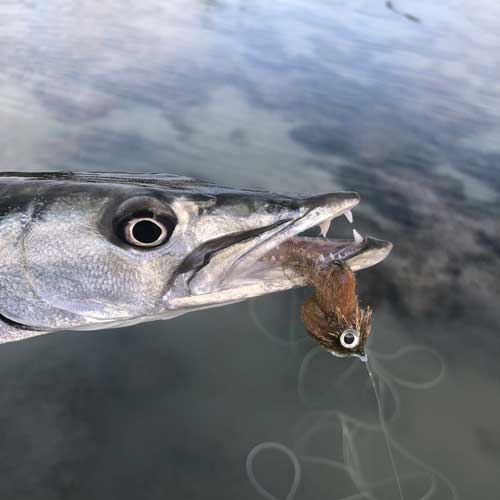 “What is emphatic in angling is made so by the long silences—the unproductive periods,” Thomas McGuane wrote. “No form of fishing offers such elaborate silences as fly fishing for permit.”
“What is emphatic in angling is made so by the long silences—the unproductive periods,” Thomas McGuane wrote. “No form of fishing offers such elaborate silences as fly fishing for permit.”
Decades after publication of The Longest Silence, McGuane’s words still ring true. The angler passes countless hours scanning the surface for the slightest sign of nervous water and straining optic nerves to scrutinize cerulean shallows. Long periods of inactivity are punctuated by ephemeral moments of exhilaration upon actually seeing a permit—and almost always are followed by pangs of rejection.
In three trips to Xcalak since 2018, I’ve spent about two-and-a-half weeks of my life in search of my first permit. I’ve had good shots at scores of them. I’ve turned them toward my fly. I’ve even vicariously felt the thrill of capture, watching Reddmann bring a permit to hand last year.
Although still feeling the effects of the norte, our third fishing day dawned with better conditions. Castro returned from hiatus to guide DeJarnette and me. We made a long run north in the bay but didn’t see anything for three hours, so we reeled in and ran back south to a flat on the east side of Cayo Chelem. Castro announced we would try for bonefish.
I spent half an hour in the bow and made a couple of casts to solitary cruisers that showed no interest. DeJarnette took the next turn as Castro slowly pushed the panga down the flat. It appeared as barren as anything we had seen—until suddenly it wasn’t.
“Permit,” Castro said, looking at the darker green water where the flat sloped imperceptibly toward the open bay.
I took my 9-weight with a tan crab from its holder and extended it toward DeJarnette.
“You take the shot,” he said.
I stepped up on the casting deck and stripped line off the reel so it piled next to my bare feet. A wedge of six or seven permit appeared, swimming toward us. My first cast was 60 feet at two o’clock, presented precisely and delicately. They ignored the fly but kept coming. The next cast, 10 to 12 feet shorter, landed 5 feet in front of the lead fish, straight off the nose of the boat. I made long, slow strips, the fourth producing resistance. I pulled back hard on the fly line, and it came tight.
The permit raced toward deeper water, peeling line off the reel as it ran toward a dark, rocky patch. I raised the rod higher and moved the fish. It swam right to left at 50 or 60 feet, and I saw two other permit from the school swimming next to it.
“Es el jefe,” DeJarnette said.
“Yes,” Castro said. “I think he is the boss.”
The permit swam perpendicular to the bow, stunning and glorious against the flat’s sandy white bottom. Castro eased over the side of the boat and followed the fly line to the leader. The startled fish surged and took back 40 feet of line, but two minutes later Castro ran his hand down the fluorocarbon leader and seized the fish by its forked black tail. I yelled like a lunatic and slipped out of the boat to release the fish.
We watched the permit swim slowly away, and I climbed back in the boat, my arms and legs still shaking. Sitting under the high noon sun with my friends—one since Little League baseball and one since my first trip to Xcalak—I recognized the value of long silences. Without the countless refusals and fruitless hours, the moment wouldn’t have been so potent. That it happened with my friend Castro elevated it to a transcendent realm.
Lessons Learned
By the time we packed the van on Friday morning to head north to Tulum, the stock market had experienced a second record decline, businesses and schools were closing, and toilet paper and disinfectants were flying off store shelves back home. The president would declare a national emergency a few hours later.
That evening, sitting in a Tulum bar and sipping mojitos made with freshly pressed local sugar cane, we speculated about pandemic life. The next morning we hit the supermarket and loaded up on papél sanitário.
Weeks later, it’s clear we didn’t have a clue. We didn’t know months would pass before we could sit down for a restaurant dinner, go to a movie, get a haircut, or work out at the gym, or that the words “social distancing” would become more common than handshakes and hugs.
But maybe there’s a lesson from McGuane, or at least a measure of comfort: Maybe this is the longest silence; with luck, then, what is emphatic in life will be made so by it.
Bio: Trey Reid has written for numerous newspapers, magazines, and websites, and is a former field reporter for ESPN. He works in public and media relations for the Arkansas Game and Fish Commission, producing and hosting the agency’s television show Arkansas Wildlife. He also hosts the outdoor radio show The Wild Side on 103.7 FM The Buzz in Little Rock, which can also be heard as a podcast.
Photos: Trey Reid, Michael DeJarnette, Bob Haines, Lee Reddmann, and Kaettie Wenger
MORE POSTS
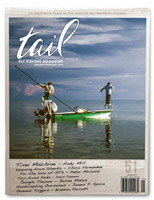 SUBSCRIBE TO TAIL FLY FISHING MAGAZINE
SUBSCRIBE TO TAIL FLY FISHING MAGAZINE
SALTWATER FLY FISHING

